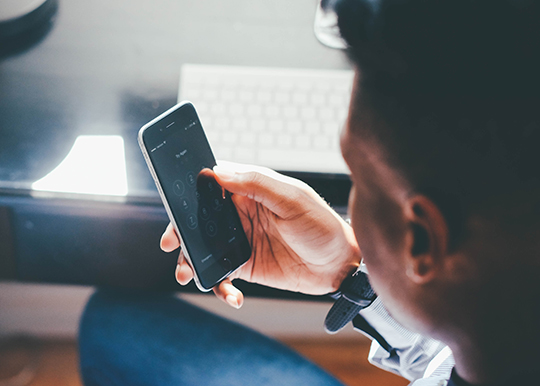Looking for Safer Ways to Pay? Go Contactless

Financial coach and business owner Nadia Busseuil has been working hard to make her day-to-day purchases as contactless as possible during the COVID-19 crisis.
If she has to pay for something in person, she uses “tap-to-pay” at checkout with her credit card or her smartphone’s wallet app. She carries small bills so that if she has to pay for something in cash, she can pay a little extra and tell an employee to keep the change. She orders her family’s groceries for delivery.
She even carries around a baggie of cotton swabs in case she has to touch a keypad.
“I have two kids at home, so I have to take extra precautions,” Busseuil says. “I don’t want something as minor as going to the store to be what makes me bring COVID back.”
Busseuil isn’t just a safety-conscious consumer; she’s also translating her health concerns to her business, the Macdonough Cafe in Brooklyn, New York. Her cafe has been closed during lockdown, but the business was already accepting customer payments via Square, a point-of-sale service that accepts contactless card payments as well as smartphone payments via mobile wallet apps. Though some customers might have been used to paying in cash, Busseuil found that most adapted easily to contactless payments.
Breaking old habits of forking over cash or swiping a credit card may be challenging, but contactless payments themselves are easy to use and may even help slow the spread of the coronavirus. Here’s what to know about the possible risk involved with using physical payments, as well as what kinds of contactless payments can be used to reduce exposure.
Can the coronavirus be transmitted by touching cash?
The Centers for Disease Control and Prevention advise that physical cash — as well as credit and debit cards — could be a potential source of exposure to the coronavirus.
However, as with any contact with commonly touched items and surfaces, basic sanitary measures can reduce risk. If you must handle cash, debit cards or credit cards, the CDC recommends that you:
- Avoid touching your face afterward.
- Avoid placing payment directly in anyone’s hands; instead, set it down on the counter.
- Disinfect any surfaces that the money or cards have touched as well as keypads, cash registers and payment terminals.
Opt for contactless payments when you can
Tap your credit or debit cards instead of swiping or inserting
Many new debit and credit cards are enabled to work with near-field communication technology, meaning they can be tapped at a payment terminal instead of inserted or swiped. If you see a marking on your card that looks like a sideways Wi-Fi symbol, that means your card has NFC.
Use a mobile wallet
Mobile devices are also usually equipped with NFC technology, allowing you to use a wallet app such as Google Pay, Samsung Pay or Apple Pay to make payments with a retailer. These wallet apps either come with your smartphone or can be downloaded, and they can be used with smartphones or smart accessories like the Apple Watch. Set up a mobile wallet by entering payment card information into the secure wallet app; to use, hold the unlocked smartphone up to a payment terminal and confirm. The total will be withdrawn from the payment card on file.
Send funds with peer-to-peer payment apps
If you need to give money to friends or family, see if you can do it digitally. There are many options these days including apps like Venmo, Cash App, Zelle, digital wallets, social networking apps and more. These apps typically are linked to the user’s checking account or, in some cases, a credit card.
Nadia Malik, a Dallas-based personal finance blogger at SpeakingofCents.com, has started using Zelle — a money transfer service that’s available through many banks as well as an app — to make payments for her children’s extracurricular classes and to accept donations to a charity she volunteers for. She’s become a fan of Zelle, she says, because it’s free, fast and reliable, and once you’re enrolled, it’s easy to send money. She says that she could see using the app in the future to pay other service providers, like the company that does her yardwork.
“I don’t see this pandemic going away soon, so this will be a new lifestyle,” Malik says. “Contactless apps and platforms are going to be very helpful.”
Pay online and make a contactless pickup or delivery
Many businesses are offering ways for customers to buy items online and either make a pickup or order delivery, which gets rid of the need for any in-person payments.
Dryden Driggers, a financial coach based in Portland, Oregon, is a longtime fan of online ordering. In an effort to reduce the risk of exposure even further for her family during the pandemic, she’s tried to avoid stores and restaurants altogether and order online as much as possible. Many nearby businesses, she says, have gone contactless for payments; some are even waiving delivery fees. Customers seem to be adapting well, too.
“We decided to treat ourselves to Starbucks recently, and there was a woman in front of us in line who wanted to do something kind and pay for us,” Driggers says. “But we had already preordered and were just picking up, so we offered to pass it to the next person. She ended up paying for someone who was three people behind us because everyone had preordered online.”
As more businesses and consumers become accustomed to contactless payments, people can enjoy the benefits of faster transactions in addition to helping prevent the spread of disease. For more tips on how you can adjust your financial life in response to the coronavirus, check out NerdWallet’s guide to COVID-19 and your money.


